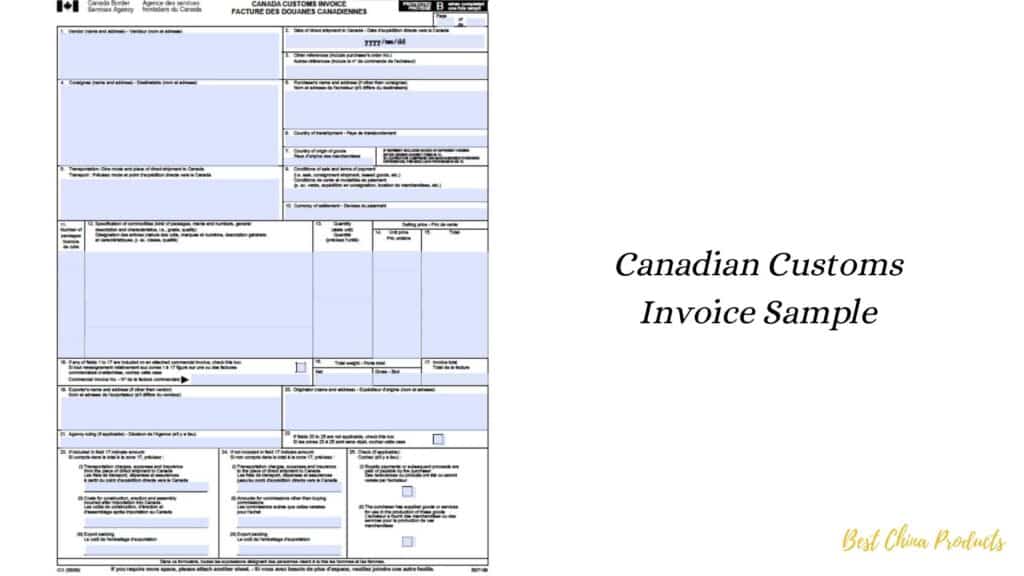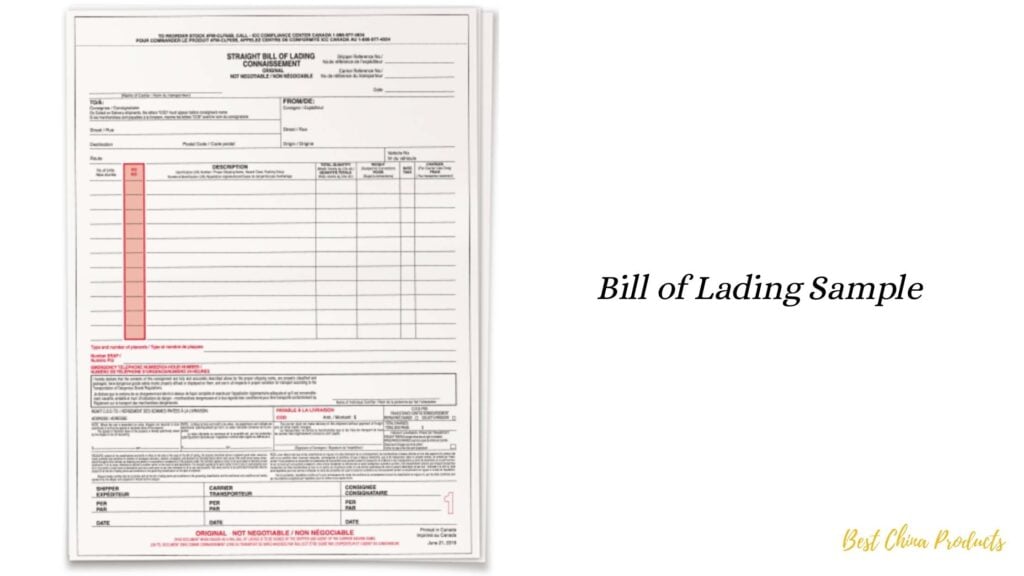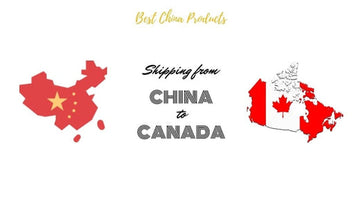Are you looking to import products from China to Canada? Whether you're a business owner or an individual shopper, understanding the shipping process is crucial.
This guide walks you through everything you need to know—from choosing the right shipping method to navigating customs requirements and minimizing costs.
| Shipping Methods China to Canada | Cost | Duration | Restrictions |
|---|---|---|---|
| China Post Air Mail | $5-$50 | 10-60 days | Maximum weight limit of 2kg |
| ePacket | $2-$20 | 7-30 days | Maximum weight limit of 2kg |
| DHL Express | $20-$200 | 3-7 days | No restrictions |
| FedEx International Priority | $30-$250 | 2-5 days | No restrictions |
| UPS Worldwide Express | $25-$200 | 2-5 days | No restrictions |
| China Post SAL | $10-$100 | 20-50 days | Suitable for larger packages, maximum weight limit of 30kg |
| China Post Sea | $50-$150 | 20-60 days | Suitable for larger packages, maximum weight limit of 50kg |
| Sea Freight - FCL | $1000-$3000/container | 20-35 days | Full container load only, minimum weight limit of 1500kg |
| Sea Freight - LCL | $150-$500/cbm | 30-45 days | Less than container load, minimum weight limit of 500kg |
| Air Freight | $2-$6/kg | 2-10 days | Minimum weight limit of 50kg, maximum weight limit of 1000kg |
Shipping from China to Canada Complete Guide 2025
Step 1 -- Acquire the relevant certificates and licenses

When shipping from China to Canada, there are a number of things you have to follow so your goods reach you in a timely manner. The below mentioned steps are important and have been laid out by the Canadian government for all imports into Canada.
Documents required for shipping from China to Canada
When it comes to shipping goods from China to Canada, there are several important documents that you will need to prepare and submit to ensure that your shipment arrives safely and on time. Below are the most common documents required for shipping from China to Canada:
- Commercial Invoice: The commercial invoice is a document that provides details about the goods being shipped, including the quantity, value, and description of each item. This document is used by customs officials to determine the value of the shipment and to calculate any applicable duties and taxes.

- Bill of Lading: The Bill of Lading is a legal document that serves as a contract between the shipper and the carrier. It includes information about the shipment, such as the name and address of the shipper and consignee, the type and quantity of goods being shipped, and the date and place of shipment.

- Packing List: The packing list is a document that provides details about how the goods are packaged, including the weight, dimensions, and number of packages. This document helps customs officials to verify that the shipment matches the information provided on the commercial invoice.

- Certificate of Origin: The certificate of origin is a document that verifies the country of origin of the goods being shipped. This document is required by customs officials to determine whether the goods are eligible for preferential treatment under any trade agreements between China and Canada.

- Export License: If the goods being shipped require an export license from the Chinese government, then this document must be obtained and included with the other shipping documents.

- Insurance Certificate: If the goods being shipped are insured, then an insurance certificate must be included with the other shipping documents.
It is important to note that the specific documents required for shipping from China to Canada may vary depending on the type of goods being shipped and the shipping method used. I recommend working with a reputable shipping company or freight forwarder who can provide guidance on the specific requirements for your shipment.
Get a business number from the CRA

The Business Number (BN) is a unique nine-digit identifier that the Canada Revenue Agency (CRA) assigns to businesses in Canada for tax purposes. When importing goods from overseas, the BN is used as the importer account number for customs purposes.
However, if you are a non-resident importer (NRI), you will need to obtain a Business Number with an import/export RM account identifier. This is known as a BN9 account. The BN9 account is a Business Number that is specifically designed for NRIs who import goods into Canada.

To apply for a BN9 account, you will need to complete the RC1 Request for a Business Number (BN) form, and indicate that you require an import/export RM account identifier. You will also need to provide supporting documents, such as proof of business registration and identification.
Once your application is processed and approved, you will receive a BN with an import/export RM account identifier. This BN will be used as your importer account number for customs purposes when importing goods into Canada as a non-resident importer.
Apply for the import permit and certificates

Before you can legally ship goods from China to Canada, you need to apply for an import permit as well as keep the Canadian government informed about what type of goods are being brought in.
Apart from the import permit, you must also apply for the import inspection in Canada.
This is where the officials will cross-check their database and see whether the goods you’re planning on shipping into Canada are of a set standard and can be legally brought into the country.
Now that you have cleared the inspection you can go ahead and apply for the permit and receive the final certificates from the authorities.
Determine the customs duties and taxes
It’s now time to determine just what category your goods fall under and which tax slab you have to pay to import your goods.
It’s good to estimate in advance just how much you’re going to pay on import duties and taxes so you can have a clear understanding of how expensive it’s going to be to ship goods from China into Canada.
You will have to consider goods and service tax, sales tax, provincial sales tax, excise tax and excise duty depending on the classification of goods you’re shipping into Canada.
One great place to check what tariff treatment applies to your goods is the Government of Canada web portal. Here you can check the Canadian Customs tariff schedule and find the most appropriate tariff treatment for your goods.
Step 2 -- Decide on your mode of shipping

There are only two ways you can ship goods from China into Canada, via Air and the Sea. Air freight and Ocean freight each have their own advantages and disadvantages, so let’s break down what they both mean and which one of the two is best suited for you.
Air Freight from China to Canada

Air freight is one of the easiest modes of shipping from China to Canada and probably the fastest mode. However, it is rather expensive and if you’re looking to save money while shipping from China to Canada, then Air freight is not the logical choice.
Advantages
- Speedy delivery: Air cargo usually takes only a few days to arrive, which is much faster than shipping by sea.
- Global accessibility: Airports are located all over the world, making air freight a convenient option for international shipping.
- Increased security: Air cargo is subject to strict security measures, which can give peace of mind when shipping valuable or sensitive items.
Times
The exact time it takes for air freight to travel from China to Canada will depend on a few factors, such as the origin and destination airports and any layovers or transfers. However, as mentioned earlier, air freight typically takes only a few days to arrive.
Costs
The cost of air freight from China to Canada will depend on several factors, such as the weight and size of the shipment, the origin and destination airports, and any additional services required (such as insurance or expedited delivery). However, the speed and convenience of air freight often come with a higher price tag than other shipping methods.
Restrictions
There are some restrictions on what can be shipped by air freight, such as hazardous materials or items that are considered illegal in either China or Canada. Additionally, some items may be subject to additional customs duties or taxes.
Ocean freight from China to Canada

There are two modes of ocean freight transportation when shipping from China into Canada, LCL or less than carrier load and FCL or full container load.
- LCL (Less than container load) - You will choose LCL ocean shipping when you don’t have a full container loaded with goods. It’s a great way to save on shipping costs and you get to share the container with different businesses that are shipping from China to Canada.
- FCL (Full container load) - FCL is a mode of ocean shipping where you pay for an entire container and have only your goods shipped in that particular container as opposed to sharing it like in LCL shipments.FCL is a cost-effective way to ship from China to Canada only if you have a full container of goods and it’s at its maximum load.
Alternate modes of shipping from China to Canada
If you don’t have a large consignment to ship then you can resort to using one of the smaller shipping methods available. This is ideal for those looking to ship small packages like samples and individual items as you will pay only for the weight and dimensions of the product.
- Regular Post - When shipping from China, China Mail and EMS are two affordable options when shipping small quantities of goods. The only drawback is that you will have to wait for a longer period of time for your shipment to arrive.
- Express shipping - Slightly more expensive than regular post, express shipping involves third-party carriers like DHL, FedEx and UPS. Here you will be charged a small premium to have your goods delivered to you in a timely manner. However, in order to get the best prices from express shipping carriers, you will have to register with the shipper and avail their benefits.
Step 3 -- Determine the Shipping Costs

Depending on the mode of shipping you selected, the costs would vary. For example, standard air freight is much more economical than ocean freight and is much faster. But there are different factors that determine the shipping costs.
Let’s take a look at what factors are taken into account when calculating the cost of a shipment.
- The type of item being shipped
- The weight of the goods in your shipment
- The volume and dimensions of the goods
- Type of shipping method selected
- Mode of delivery selected such as dood-to-door, port-to-door or port-to-port
Air shipping costs from China to Canada
When you have your consignment shipped via Air freight, the shipping charges are based on the overall weight of the shipment. Air cargo is calculated based on the total number of kg being shipped. It’s also good to know that the heavier the consignment is, the less you pay for shipping.
| Shipment Weight | Air Freight Rate |
| 45kg Low | $9.55 |
| 100kg Low | $8.54 |
| 200kg Low | $8.54 |
| 300kg Low | $8.29 |
When shipping via Air freight, port-to-port shipments would be calculated for an average load of 200kg/1 cbm.
Ocean shipping costs from China to Canada
OCean freight is much cheaper than air freight but you would have to wait for around 15-30 days for your shipment to reach its destination. Shipping via the sea route is favoured when the overall volume of your consignment is too high to be economical via air freight.
When shipping from China via ocean freight, the amount you pay will depend on the type of container hold you selected. It’s cheaper to ship a smaller quality of goods via the LCL method over FCL.
Take a look at the rough estimates for LCL and FCL shipping modes.
| FCL From and To | FCL Rate |
| Shanghai - Vancouver (Low) | $5,086 |
| Shanghai - Montreal (Low) | $6,098 |
| Ningbo - Vancouver (Low) | $5,086 |
| Ningbo - Montreal (Low) | $6,098 |
| Shenzhen - Vancouver (High) | $5,652 |
| Shenzhen - Toronto (High) | $7,473 |
| LCL From and To | LCL Rate |
| Shanghai - Vancouver (Low) | $150.72 |
| Shanghai - Montreal (Low) | $194.68 |
| Ningbo - Vancouver (Low) | $182.12 |
| Ningbo - Montreal (Low) | $226.08 |
| Shenzhen - Vancouver (High) | $150.72 |
| Shenzhen - Toronto (High) | $188.40 |
Step 4 -- Purchase Shipping Insurance

Different shipping carriers provide different insurance slabs on consignments depending on the way they are being shipped and what the contents of the shipment are.
Generally when you pick the best shipping carrier for your needs, they will inform you if you have to pick up insurance for your shipment or not.
Ideally, it’s best to have your shipment insured regardless of the value since the package will travel halfway around the world and will be loaded and unloaded numerous times which can result in damages to your shipment.
The only problem with purchasing insurance is that not every item on your manifest will be insurable. For example, personal items such as TV’s, perishable goods, artwork, and liquids won’t be insured.
Another reason why insurance won’t be applied on your consignment is if you have not met the ista-3a packaging standards.
Step 5 -- Choose the right vendor to deal with

Choosing the right vendor to source products from China will be a task but there are some easy ways around this. Since you are going to import goods into Canada, you will need to ensure that the products are made from high-quality materials and that the supplier should be a reliable source with a decent customer satisfaction rating.
Here are some of the types of vendors you can choose from when shipping from China to Canada.
- B2B Marketplaces - Alibaba is one of the best places to source products from China for your business in Canada. You will be able to choose from a large collection of sellers and wholesalers here and to ensure that you have the best quality products at the best prices, get in touch with a factory supplier instead of a store.
- Chinese sourcing agents - It’s a good idea to get a sourcing agent based out of China as they will be able to not only check the quality of your products before they’re shipped but they also have good relationships with factories and suppliers which makes it easier for you to get products from China.
- Use a good search engine - These days it’s easier to get in touch with suppliers directly by reaching out to them through online means. Simply typing out relevant keywords such as Chinese wholesale dealers for any particular category and you will have access to hundreds of such sellers that are based out of China.
How Long Does it Take to Ship Goods from China to Canada?
The duration it takes to ship goods from China to Canada depends on the carrier selected and the type of shipping method you opted for.
| Shipping Method | Duration | Freight Options | Express | Land Mail |
|---|---|---|---|---|
| Air Freight | 2-5 days | Yes | Yes | No |
| Sea Freight | 15-35 days | Yes | No | No |
| Express Courier | 3-5 days | No | Yes | No |
| Land Freight | 10-14 days | Yes | No | Yes |
- Regular Post - Shipping via surface mail or China Post will take around 1-2 weeks for your consignment to arrive. If you wish for your package to arrive earlier than 2 weeks, ensure that all your documentation and import/export paperwork is in place.
- Express Shipping - Express shipping is the fastest of the lot and would take roughly 3-5 working days to be delivered. This form of shipping is expensive and there are different tiers of shipping charges with regards to express shipping such as overnight express or expedited express.
- Air Freight - Air freight takes around a week to arrive depending on the weight and type of goods being shipped. Generally air freight is meant to be the fastest mode, but it also has one of the most complicated shipping processes out there and this takes more time to complete.
- Sea freight - Shipping your goods via the sea route can take anywhere from 15-35 days to arrive. It’s by far the slowest shipping method out there but also one of the most economical if you have the right shipping parameters.
Tips on how to minimize costs when shipping from China to Canada
- If you’re planning on using the sea freight option to ship goods from China to Canada, make sure you book your shipment in advance as this is one of the slowest shipping modes and will ultimately save you some money.
- Avoid peak seasons when shipping goods because this is normally when shipping companies increase the cost of shipping and the overall transit time will also greatly increase.
- Keep all your documents in hand and make sure you don’t have any hassle while clearing customs. This will minimize the chances of incurring a customs penalty.
- Always double check the shipping costs of different carriers so you are aware of the price differences and you ultimately choose the best offer.
- Understanding the inclusions and exclusions of your shipping fees is important because it will help you determine whether the shipment will be delivered to your doorstep or port.
Shipping from China to Canada FAQs
How long does it take to ship from China to Canada?
Express: Fastest (1-4 days) but most expensive. Ideal for urgent or small shipments.
Air Freight: Faster than sea (6-13 days) but pricier. Good for medium-sized, time-sensitive shipments.
Sea Freight: Most affordable (29-33 days) but slowest. Best for large, non-urgent shipments.
Do I need to pay customs duties and taxes on my shipment?
How can I track my shipment from China to Canada?
What is the fastest way to ship from China to Canada?
What does Canada import mostly from China?
What happens if my shipment is damaged during transport?





